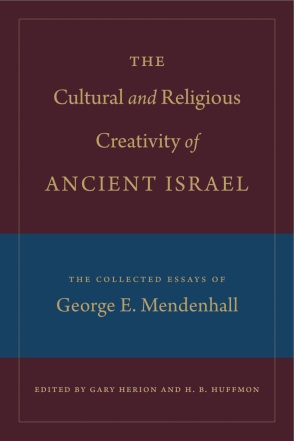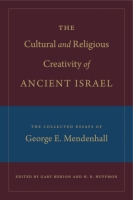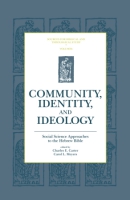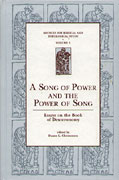
The Cultural and Religious Creativity of Ancient Israel
The Collected Essays of George E. Mendenhall
Edited by Gary Herion and H. B. Huffmon
The Cultural and Religious Creativity of Ancient Israel
The Collected Essays of George E. Mendenhall
Edited by Gary Herion and H. B. Huffmon
Throughout his long and influential career, George E. Mendenhall published groundbreaking, provocative studies on the history of the biblical tradition, law, and covenant and the Hebrew conquest of Palestine. This volume collects thirty-four of his hardest-to-find essays, many of which originally appeared in journals and other publications with limited circulation.
- Description
- Bio
- Table of Contents
- Sample Chapters
Mendenhall’s corpus of more than one hundred books, articles, and reviews has stimulated remarkable work by scholars in the twentieth century. Even today, students of the Bible, the ancient Near East, archaeology, Judaism and Christianity, and even theology will find in these essays untapped veins of material for future study and provocative insights about a wide range of still-critical issues, suggesting that Mendenhall’s work can continue to galvanize a rich agenda for the study of biblical faith and history in the twenty-first century. The volume contains critical essays by Gary A. Herion, Herbert B. Huffmon, and Peter Machinist that summarize Mendenhall’s impact on ancient and biblical studies; links for downloading a recent film documentary on Mendenhall’s life and work; and excerpts from Mendenhall’s autobiography, which he was working on at the time of his death.This volume contextualizes and updates the lesser-known work of this well-known and celebrated biblical scholar. It will be welcomed by students and specialists of the ancient Near East, Semitic linguists, theologians, interested clergy and laity, and, in particular, those who study the creative formation of religious traditio
ns.Gary Herion is Professor Emeritus of Religious Studies at Hartwick College.
Herbert B. Huffmon is Professor Emeritus of Old Testament Studies at Drew University.
List of abbeviations
Preface: The Contribution of George Emery Mendenhall
Excerpts from My Life of Adventure: The Early Years by George E. Mendenhall
George Emery Mendenhall (1916–2016), by Peter Machinist
I. General Perspectives on Religion and the Human Condition
Man Is More than Political (1956)
It’s Great to Be Human! (1961)
The Conflict between Values Systems and Social Control (1975)
The First Half of Human History (1974)
II. Approaches to the History of Ancient Israel
Biblical History in Transition (1961)
Migration Theories vs. Cultural Change as an Explanation for Early Israel (1976)
Method in the Study of Early Hebrew History (1964)
The Ancient in the Modern—And Vice Versa (1976)
Toward a Method for Historical Lexicography of Semitic Languages (1990)
Biblical Interpretation and the Albright School (1987)
III. Praeparatio: The Near Eastern Context of Ancient Israel
The Amorite Heritage in the West (2004)
Myth, Ideology, and the Worship of Baal (1985)
Jerusalem in the Amarna Letters (2007)
Cultural History and the Philistine Problem (1986)
Qurayyah and the Midianites (1984)
IV. The Formative Period: The Origins and Formation of Yahwistic Israel
Covenant Forms in Israelite Tradition (1954)
The Hebrew Conquest of Palestine (1962)
Social Organization in Early Israel (1976)
“Change and Decay in All Around I See”: Conquest, Covenant, and the Tenth Generation (1976)
Between Theology and Archaeology (1978)
Ancient Israel’s Hyphenated History (1983)
The Suzerainty Treaty Structure: Thirty Years Later (1990)
V. The Adaptive Period: Yahwistic Faith in an Ancient Near Eastern Setting
Ancient Oriental and Biblical Law (1954)
The Relation of the Individual to Political Society in Ancient Israel (1960)
The Census Lists of Numbers 1 and 26 (1958)
Samuel’s “Broken Rîb”: Deuteronomy 32 (1975)
The Monarchy (1975)
The Nature and Purpose of the Abraham Narratives (1987)
VI. The Traditional Period: Religion under the Monarchy
Jerusalem from 1000 B.C.E. to 63 B.C.E. (1989)
Prophecy and Poetry in Modern Yemen (2000)
VII. Reformation: Reappraisals of Tradition after the Monarchy
The Shady Side of Wisdom: The Date and Purpose of Genesis 3 (1974)
From Witchcraft to Justice: Death and Afterlife in the Hebrew Bible (1992)
The Palestinian Grassroots Origins of New Testament Christology (1986)
Epilogue: Is Generation X the Tenth Generation? (1999)
Appendix 1: George E. Mendenhall: A Bibliography of His Writings and Publications (1938–2007)
Appendix 2: George E. Mendenhall’s Graduate Students and Their Dissertations
Works Cited
Index of Authors
Index of Scripture
Subject Index 577
From the Preface
The Contribution of George Emery MendenhallOn August 5, 2016, George Mendenhall passed away, eight days short of his one hundredth birthday. He had emerged from a Great Plains family of Lutheran ministry—his father and two older brothers were Lutheran ministers, and his mother was the daughter of a Lutheran minister—and George initially followed that same path. But his accidental encounter with William F. Albright, under whom he studied from 1938 to 1942 and again in 1946–1947, was central. Starting in 1954, Mendenhall published a series of seminal essays that stirred scholarly debate on several continents. And he continued to explore new directions into his nineties, seeking to shift some of the basic paradigms in the study of the ancient Near East with a focus on historical linguistics and the achievements of ancient Israel. Such paradigm shifters are considered “giants” in the field, and even though they may be dead and buried, they can continue to stir the perceptual world of scholarship.Intellectual InfluencesGeorge Mendenhall was very much an intellectual disciple of William F. Albright, sharing Albright’s fascination with the historical process, the way that human processes—including religiously held values—shape social institutions, influence the culture, and set in motion forces that will have repercussions in the future. Mendenhall understood that the study of such historical processes is forensic in nature, requiring not only responsible judgments gleaned from a wide variety of perspectives and disciplines but also a critically informed imagination to help reconstruct what had once transpired so long ago and to speculate as to why.Like Albright, Mendenhall was deeply concerned about the corrosive impact that modern ideologies play in shaping this imagination in uncritical ways. For Albright, the twin pillars for the historical reconstruction of ancient Israelite history had been archaeology and historical analogy, and in the middle third of the twentieth century, these two alone could be all-consuming, especially given the explosion of new data emerging each year from excavations and from newly accessed texts whose contents described potentially relevant analogues. Few did it better than Albright. But Mendenhall sought to expand this range of perspectives, and in so doing, he became one of the acknowledged pioneers in the multidisciplinary study of the Bible and Israelite history.Two emerging disciplines in the study of the ancient Near East especially drew Mendenhall’s interest: Semitic historical linguistics and the social sciences. In Albright’s day, the social sciences had still been comparatively new and undeveloped at Johns Hopkins, but as early as the 1950s, Mendenhall found a very different and more congenial atmosphere at the University of Michigan. There he was constantly engaged in fruitful conversations not only within the diverse and multidisciplinary Department of Near Eastern Studies (for which he repeatedly praised its foresighted chairman, George G. Cameron) but also with prominent colleagues in other departments, such as Paul Kauper (Law), Gerhard Lenski (Sociology), Kenneth Boulding (Economics), Elman Service and Louise Sweet (Anthropology), Ernst Pulgram (Linguistics), and Frederick Wyatt (Psychology). The essays that follow show Mendenhall’s social science approach, especially as it is reflected in his sensitivity to ancient village life. The submerged eighty percent of ancient people in the Near East were born in villages, labored in the surrounding fields and steppes to produce the basic goods that helped sustain themselves and the more remote elite, and then died there. Being largely nonliterate, they left few texts for historians to synthesize, and those contemporaneous texts that do exist—produced almost exclusively by urban elites—often reflect disdain (if not contempt) for these rustics. Modern historians, focusing on such written documents, are properly sensitized to the social and historical changes they attest, but Mendenhall noted that this comes with a price—not only a lack of critical regard for the continuities that exist but also a (sometimes scornful) disregard for the disparaged eighty percent responsible for maintaining that continuity.Mendenhall had a marked sympathy for nonurban nonelites, perhaps to the point of even identifying himself personally with them. Growing up in the rural Midwest and Great Plains states, he understood that rural life is always conservative and that cultural continuity (whether of archaic technologies, social patterns, or ideological/religious outlooks) is preserved in the comparatively unchanging countryside. Given the general dearth of historical texts from ancient villages actually proving this (or disproving it), Mendenhall insisted upon a shift in the “burden of proof ” by appealing to the anthropological adage that “it is not cultural continuity that needs to be explained, but cultural change.” For him, cultural continuity in the countryside was a “given” that one did not have to prove (although such proof is not lacking); thus, the burden now falls upon the historian who would ignore this continuity or dismiss its potential significance.An Albrightian focus on the historical process—especially in antiquity—must also consider questions of teleology, questions of how things come to their appropriate end. For Mendenhall, nothing reinforced this teleological question more than the thick ash layers discovered among the ruins of the once-great urban power centers of the Late Bronze Age. Sometimes rapidly, sometimes not, social organizations and cultural configurations indeed decline and collapse, often amid much chaos and violence. Mendenhall seems to have sensed in this teleology the central irony of history: despite all their resources of power and wealth, the elite (twenty percent?) who control society and direct its course of events cannot, in the end, prevent their own corporate demise. Indeed, the historical record suggests that their characteristic resort to political craftsmanship—exercising their power and deploying their resources to solve “problems”—very often only made things worse. Mendenhall wanted to know why.This curiosity is arguably what drove his methodological emphasis on function above form, especially when it came to the ideological features of a culture as reflected in religion, language, law, customs, and morality. As a historian, Mendenhall wanted to know why people in antiquity made the choices that they did and whether or not they were all that different from people today. This, in turn, sensitized him to the real underlying issue: motivation. He believed that social history becomes broadly predictable once one understands the operating beliefs, values, and motivations held by those elites who possess the resources to influence the larger social environment. He claimed that the biblical tradition’s great and unique contribution to world civilization is precisely its emphasis on the relationship between values and historical processes, and it clearly frustrated him that far too many religious leaders and theologians refused to even acknowledge this, despite claiming for themselves guidance and inspiration from that same biblical tradition.The theological value of Mendenhall’s study of the historical process perhaps lies in the realization that there are no fundamental differences between the value systems that operated in the past and those that, for example, still operate today in Western culture (the exotically archaic social world of the Bible notwithstanding). This is especially true among elites, whether sociopolitical, academic, or even ecclesiastical. To the extent they accommodate institutional (if not personal) self- interest and self- righteousness, their operating values not only degrade personal, institutional, and cultural operations but also, if unchecked by a better set of values, harbinger the end of civilized order. Consequently, there is a sense of apocalyptic foreboding in much of Mendenhall’s writing about the historical process. This could be dismissed by midcentury critics whose own sense of teleology was still under the charm of “enlightened” ideology and of a more “progressive” outlook on the eventual triumph of the West’s allegedly superior set of allegedly “liberal” values. At the same time, Mendenhall reserved some of his harshest criticisms for conservatives who exploited religion for political gain, thereby nudging everyone a bit closer to the apocalyptic brink.When all is said and done, there remains a mystery surrounding the intellectual influences that enabled Mendenhall to synthesize all his learning in the unique way that he did. Thus, while it is fairly easy to trace the impact of larger historical, cultural, and intellectual forces on major academic trends and schools in biblical studies—such as nineteenth- century literary criticism, or mid- twentieth- century biblical archaeology, or even the biblical minimalism that surfaced at century’s end—this is not so easy when one encounters a genuine intellectual maverick like George Mendenhall.What inspired him to reimagine Israelite religion and especially early Israelite history in the unprecedented and idiosyncratic way he did? What emboldened him so often to deviate so radically from the trends and conventions of both academic and ecclesiastical establishments? There are perhaps suggestive hints in his autobiographical reflections about his early years (excerpts of which appear on pages xxiii-l of this volume), but we ourselves could find no clear and obvious answers.Editing MendenhallLike so many other extremely bright thinkers, George Mendenhall was not always meticulous, disciplined, or articulate in systematically organizing and clearly explaining to others the often revolutionary (and therefore challenging) insights that he wanted them to see and engage.By the time he was forty- six years old, his signature works on law (1954), covenant (1954), and conquest (1962)8 had already secured his reputation as a world- class scholar. We are pleased to reprint these three major articles in this collection. These were carefully researched, apparently went through several drafts, and benefited from careful scrutiny within the confines of the Biblical Colloquium. In the following decades, Mendenhall was very much in demand. As Albright’s generation retired (as Albright did in 1958) and as some of Albright’s students and associated scholars retired (or, in some cases, passed away), Mendenhall contributed to Festschriften for his teachers and colleagues, and he also contributed to special occasions, such as the 100th meeting of the Society of Biblical Literature. Many of these volumes had a somewhat limited distribution, so we are pleased also to re- present here these later essays.In 1998, Mendenhall himself (now in his early 80s) conceded the awkwardness of his personal style of writing,10 and in preliminary conversations about reprinting some of his articles, he agreed that many of his later essays could be “tightened up” to enhance clarity and flow. Consequently, we have added section- and (in some cases) subsection- headers. We have taken many longer paragraphs and broken them up into shorter (and yet coherent) sense units. We have also taken some of the lengthier and more complex sentences—sometime with two (or more!) dependent clauses—and divided them into two (or occasionally three) shorter sentences. On quite a few occasions, when it seemed appropriate, we have recast verbs in the active voice and repositioned them syntactically so as to smooth out the “flow” and sharpen the focus of Mendenhall’s remark. We have added biblical citations where we deemed they would be helpful to the general reader; we have occasionally updated a footnote so as to include more recent scholarly discussions of a given topic; and we have occasionally toned down an exuberant comment or a sweeping statement. Also, some obvious digressions have been shifted to footnotes. We have also inserted pull quotes to help pique the interest of readers less familiar with Mendenhall’s work.Mendenhall gave tacit support for all this; he favored reediting rather than a rote reprinting because he wanted to re- present his work to new or forthcoming generations of students and scholars. This same policy led us to set aside some digressions that were specifically directed at a much earlier audience in a highly charged world within which Mendenhall himself had strong convictions, usually representing a contrarian point of view. Of course, Mendenhall himself was not able to review these editorial changes, but we have followed his general guidelines for reprinting. We felt deeply honored by the trust he placed in us to “curate” these publications for twenty- first- century readers. Unfortunately, his declining health required us to plow ahead without his final review of this finished text.The Arrangements of the ArticlesThe first section (“General Perspectives”) contains essays that are perhaps most accessible to the general reader, expressing Mendenhall’s broad humanistic understanding of religion and the human condition. The second section (“Approaches to the History of Ancient Israel”) contains articles that, in large part, examine methods and assumptions related to the critical study of ancient Israel’s history, beginning with Mendenhall’s 1961 article outlining a proposed “five-period” model (inspired by Albright) for approaching the history of Israelite religion. This section concludes with his reflective essay on the legacy of Albright and his “school.”(Excerpt ends here.)
Also of Interest
Mailing List
Subscribe to our mailing list and be notified about new titles, journals and catalogs.





